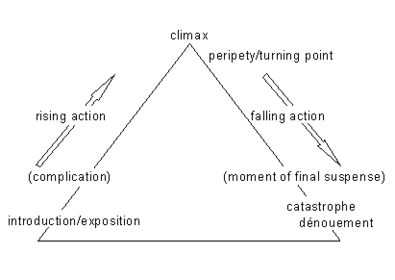Fechar

Textual concepts:
Contextual concepts:
Criteria for Literature
Quantitative Criterion:
Criteria for Literature
Qualitative Criterion:
Textual concepts of Literature:
real vs. fictional
mimesis
poiesis
literariness / poeticity
textual concepts of literature
other specific features
Contextual concepts of literature:
literature as a social practice
literature as a working definition
different readings of hamlet
hamlet as a revenge tragedy:
hamlet as study on seeming and being
hamlet as Freudian play
hamlet as study on patriarchy
literary critisicsm
meanings of a text
approach to literary criticism
Different schools, approaches and methods of literary criticism:
approaches centering on literary context
author-centered approaches
context-centered approach
text-centered approaches
reader-centered approaches
Roman Jakobson assigned six functions of language
Emotive/expressive function:
Conative function:
Referential function:
Phatic function:
Metalingual function:
Poetic function:
The literary system is
the definition of literature:
signals or indicators of fictionality
Contextual signals of fictionality
paratextual signals of fictionality
A characteristic feature of literature is ambiguity or polyvalence
According to Jakobson´s communication model, literariness is determined by the dominance of a particular function of the language
Literature can also be defined as
literary language
Metalanguage refers to
textual analysis
Textual interpretation
hermeneutics
Other factors that influence the interpretation of a text
An interpretation has to fulfil certain criterions to be regarded as scholarly:
The goal of interpretation is
STORY / PLOT
DISCOURSE
Narrativity can be defined as
The author of a story is not the mediator
The plot structure can be categorized via different terms:
teleological
cyclical
episodic
static

Characterization
static character
one-dimensional type character
personification
characters: individual and type
Characterization is concerned with
figural and authorial characterization
explicit characterization
implicit techniques of characterization
Figural forms of characterization
Techniques of characterization used in narrative texts must be considered under the question of
Story refers to
discourse
Story and Plot
story meaning
plot means
The smallest unit of a plot is called
Temporal Structure:
Order refers to
Discourse time refers to
Duration is the
Frequency deals with
singulative narration
repeating narration
iterative narration
Space:
Different functions of space could be:
The narrative situation
forms of narration
Homodiegetic
Autodiegetic
Heterodiegetic
The form of narration (Erzählformat) is another thing to consider
Focalisation (Fokalisierung):
External Focalisation:
Internal Focalisation:
The focalizer is
View (Bewusstseinsdarstellung):
The mode of narration can either be
The narrator and focalizer perform different functions:
Extradiegetic narrators are
An intradiegetic narrator refers to
homodiegetic narrator
A heterodiegetic narrator is
autodiegetic narrator
Focalization refers to
Focalization is external if
Focalization is internal
a so called narrator-focalizer
fixed focalization
multiple or variable focalization.
To identify the focalizer we must
free indirect discourse (erlebte Rede)
Another type is indirect discourse
stream of consciousness
Authorial narrative situation
First Person narration
Figural narration
Clues for Figural narration are:
The term ´psycho-narration´ describes a
Free indirect discourse (or ´narrated monologue´)
Narrative Situations
Brevity
Brevity in Quality
Overstructuring
Overstructuring on the level of typology
The sound is also overstructured
Deviation
Subjectivity
Selfreferentiality
Fragile aesthetic illusion
Genre: The term ´genre´ is derived from
Definitions of poetry:
brevity produces
Subjectivity is expressed via
The referential function of language points towards
The structural complexity of poems make up most of the central features of poetry, like:
The structural complexity is also found on
The rhyme scheme establishes
The most important generic features of poetry are:
Sonnets story level
Sonnets discuorse level
The Shakespearean (or ´English´) sonnet has
The Shakespearean (or ´English´) sonnet consists of
The external form of poetry
Types of metre:
Actual metre:
Syllabic metre:
Free Verse:
Accentual-syllabic metre:
The suprasegmental level:
How to describe the metre:
The prose rhythm:
The verse rhythm is
The prose rhythm can deviate from the metre in various ways:
Rhyme:
Types of Rhymes:
Couplets
Crossed rhyme
Chain rhyme
Embracing rhyme
Intermitted rhyme
Sporadic/occasional rhyme
Thorn line
Rhyme types depending on stress:
Full Rhyme
Rich/pure/perfect rhyme
Identical rhyme
Half/slant/pararhymes
Consonance
Assonance
Eye-rhyme
End-rhyme
Internal rhyme
Leonine rhyme
masculine rhyme
feminine rhyme
the smallest unit of verse
Types of feet:
iambic foot
trochee
dactyl
anapaest
spondee
amphibrach
A break in the metre which divides up a line of verse into parts is known as a
The rhythm of a poem is not only defined by
Caesuras are
Rhyme generally means a
Historical rhyme:
Mosaic rhyme:
Broken/split rhyme:
Rhyming Couplets
Alternate rhyme
Embracing/Envelope rhyme
Chain/Interlocking rhyme
Tail rhyme
The schematic representation of the sequence of end-rhymes within a stanza or a poem is described as its
Rhyme and other sound patterns can therefore have three functions
The Metaphor:

 Ocultar acertos
Ocultar acertos